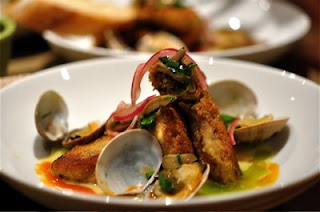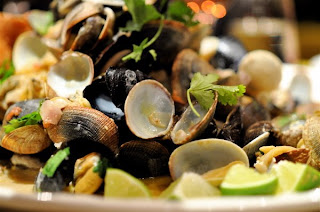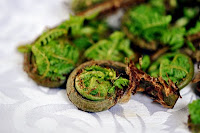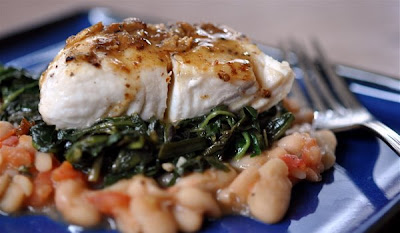 I feel like I’ve just been run through an intensive 10-week cooking class condensed into a single night. My head hurts—and not just because of all those Grand Cru wines brought home by the House Sommelier. The lesson here: Take a couple professional gourmet chefs clamming and you’ll reap the rewards. Not that it felt like work to get to the meal. I’ll take this troop clamming any day.
I feel like I’ve just been run through an intensive 10-week cooking class condensed into a single night. My head hurts—and not just because of all those Grand Cru wines brought home by the House Sommelier. The lesson here: Take a couple professional gourmet chefs clamming and you’ll reap the rewards. Not that it felt like work to get to the meal. I’ll take this troop clamming any day.
 My foraging pupils were Becky Selengut, aka Chef Reinvented, who teaches cooking classes at PCC, cooks for hire, and is co-author of the Washington Local and Seasonal Cookbook. Her old colleague from the Herbfarm restuarant, Jet Smith, joined us. And completing the trio was Amy Pennington, the gogogreengardener herself, a former lieutenant to Tom Douglas, creator of Urban Garden Share, and no slouch in the kitchen.
My foraging pupils were Becky Selengut, aka Chef Reinvented, who teaches cooking classes at PCC, cooks for hire, and is co-author of the Washington Local and Seasonal Cookbook. Her old colleague from the Herbfarm restuarant, Jet Smith, joined us. And completing the trio was Amy Pennington, the gogogreengardener herself, a former lieutenant to Tom Douglas, creator of Urban Garden Share, and no slouch in the kitchen.
 Don’t let the fem pink gloves fool you… Most of the conversation simply can’t be re-printed, as I’m trying to run a family-friendly blog here. I’ve been known to let loose some colorful language myself, but these three make drunken sailors sound prim and more than once did I blush in the hot sun.
Don’t let the fem pink gloves fool you… Most of the conversation simply can’t be re-printed, as I’m trying to run a family-friendly blog here. I’ve been known to let loose some colorful language myself, but these three make drunken sailors sound prim and more than once did I blush in the hot sun.
We started with the oyster beds, which were fully exposed by a low tide that virtually emptied this small bay in south Puget Sound. A few down the hatch and the rest into the bag.
 Did I mention the extraordinary sun? After a libation and bit of sunbathing in the beautiful sun, we attacked the clam beds. With one other clammer in sight, we had the pick of the litter. I don’t think I’ve ever raked up a limit in such record time. The clams were practically jumping out of the sand volunteering for Becky’s Grand Plan. Both native littlenecks and non-native Manila clams filled our buckets. The Manilas have short siphons and can be found just an inch or two below gravelly sand, while the natives are just a little deeper, usually three or four inches beneath the surface. On this day we found mostly Manilas—big ones too.
Did I mention the extraordinary sun? After a libation and bit of sunbathing in the beautiful sun, we attacked the clam beds. With one other clammer in sight, we had the pick of the litter. I don’t think I’ve ever raked up a limit in such record time. The clams were practically jumping out of the sand volunteering for Becky’s Grand Plan. Both native littlenecks and non-native Manila clams filled our buckets. The Manilas have short siphons and can be found just an inch or two below gravelly sand, while the natives are just a little deeper, usually three or four inches beneath the surface. On this day we found mostly Manilas—big ones too.
 A patch of sea beans (Salicornia sp.) provided the final treat. We munched on them through the day and took home enough for dinner.
A patch of sea beans (Salicornia sp.) provided the final treat. We munched on them through the day and took home enough for dinner.
Back at the ranch the cooks started working their magic. A few observations:
 Pros work very quickly. I was still polishing off my second glass of rose champagne and the ladies already had three sauces ready to go.
Pros work very quickly. I was still polishing off my second glass of rose champagne and the ladies already had three sauces ready to go.- Pros don’t get stressed out, certainly not when entertaining at home for such a small number of guests.
- Pros make it look simple but their hamster-in-a-treadmill brains are forever concocting fiendish new designs to blow the minds of their hapless victims.
Though I’ll do my best to parse the recipes here, please understand that the chefs were working improvisationally throughout and I don’t think I saw a single measuring cup or spoon on the premises. What follows is an approximation, no doubt made murkier by the myriad wines and champagnes making the rounds. (The alcohol, I now realize, is the equivalent of a forager blindfolding his charges before entering a top secret hunting ground.)
Three Sauces
 The first sauce was made by steaming a handful of clams in vermouth, shallot, parsley, and thyme. The clams were set aside for the first course and the broth strained into a blender along with some corn, blended, strained, and cooked down to a smooth sauce in a small pot, seasoned, and set aside.
The first sauce was made by steaming a handful of clams in vermouth, shallot, parsley, and thyme. The clams were set aside for the first course and the broth strained into a blender along with some corn, blended, strained, and cooked down to a smooth sauce in a small pot, seasoned, and set aside.
 The second sauce was composed simply of a small handful of parsley, blanched for 5 seconds and shocked with cold water, then blended with olive oil and salt into a cohesive oil which was strained and set aside.
The second sauce was composed simply of a small handful of parsley, blanched for 5 seconds and shocked with cold water, then blended with olive oil and salt into a cohesive oil which was strained and set aside.
The third sauce was made with a dried ancho pepper, reconstituted in warm water, seeded, and blended with tomato paste, olive oil, and salt.
First Course: Pan-Fried Pacific Oysters with Clams in Corn Sauce and Drizzled with Chili and Parsley Oils
 That’s what I’m talking about. We’re not in Kansas anymore is right. The oysters were floured, dipped in egg, and dredged in homemade breadcrumbs, then pan-fried in a generous allowance of butter. These got plated in pyramid formations in shallow bowls ladled with the corn sauce, then topped with a garnish of thinly sliced olives and red onion bathed in red vinegar to turn a jaunty fuchsia. Steamed clams and drizzles of chili oil and parsley oil completed the sumptuous picture.
That’s what I’m talking about. We’re not in Kansas anymore is right. The oysters were floured, dipped in egg, and dredged in homemade breadcrumbs, then pan-fried in a generous allowance of butter. These got plated in pyramid formations in shallow bowls ladled with the corn sauce, then topped with a garnish of thinly sliced olives and red onion bathed in red vinegar to turn a jaunty fuchsia. Steamed clams and drizzles of chili oil and parsley oil completed the sumptuous picture.
I mean, isn’t that what any of us would do with a few fresh oysters?
Second Course: Cambodian Shellfish Amok
I’ve actually made a dish similar to this, and the beauty is just how simple it is for us normal home cooks to make. My contribution on this night was to scrub the clams, which is kinda important since freshly foraged clams will have slimy stuff on their shells, while Amy scrubbed and de-bearded the mussels. Onions and kaffir lime leaves got sauteed in coconut oil in a big pot with amok powder and Thai bird chilies. Our pile of shellfish, about 140 clams and two-dozen mussels in all, was then dumped into the pot along with a can of coconut milk and steamed. The shellfish hotpot was finished with fresh lime and cilantro, and served with baguettes for dipping up the curry-like broth.
Third Course: Oyster and Sea Bean Succotash with Stir-fried Bok Choy
 We finished off the meal with a southern twist, using the bok choy as a bridge from the previous course. Chopped bok choy and onions were stir-fried with diced bacon while the succotash was composed of corn, blanched sea beans, chopped oysters, steamed and chopped carrots, chopped shallots, blanched fava beans, and diced bacon, all of which got sauteed together in bacon grease and butter.
We finished off the meal with a southern twist, using the bok choy as a bridge from the previous course. Chopped bok choy and onions were stir-fried with diced bacon while the succotash was composed of corn, blanched sea beans, chopped oysters, steamed and chopped carrots, chopped shallots, blanched fava beans, and diced bacon, all of which got sauteed together in bacon grease and butter.
 The succotash really got me. I’m rendered helpless in the presence of salty-sweet; a night at the ballpark can’t be fully consummated without a bag of kettle corn, and usually I’ll eat myself right into a barf bag, such is my weakness for salty-sweet. In this case, the sweetness of the corn and carrots married with the saltiness of the oysters and sea beans, while the crispy bacon and fava beans added textural complexity. It was a dish that, on the face of it, looked so easy, and yet its flavor was as good as anything I’ve ever eaten. I watched it happen right before my eyes and still can’t believe how good it was.
The succotash really got me. I’m rendered helpless in the presence of salty-sweet; a night at the ballpark can’t be fully consummated without a bag of kettle corn, and usually I’ll eat myself right into a barf bag, such is my weakness for salty-sweet. In this case, the sweetness of the corn and carrots married with the saltiness of the oysters and sea beans, while the crispy bacon and fava beans added textural complexity. It was a dish that, on the face of it, looked so easy, and yet its flavor was as good as anything I’ve ever eaten. I watched it happen right before my eyes and still can’t believe how good it was.
And I suppose that’s how I feel about the meal in general. Yeah, I was there to witness it but I couldn’t quite believe my senses. Our Wine Sommelier, April, who came home to this feast after a late night pre-opening party for the Grand Cru Wine Bar over in Bellevue, is one lucky lady.
Happy Cinco de Mayo everyone!






























